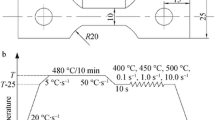Abstract
In this study, the effects of temperature, drawing speed, and mold structure on the drawing properties of AZ31 magnesium alloy sheets are examined. Experimental results indicate that the maximum drawing force gradually decreases as temperature increases, and the optimal deep drawing performance of the sheet occurs at 200–300°C. With an increasing drawing speed, the maximum drawing force first decreases and then begins to increase. If the drawing speed is too fast, it will cause a ductile fracture in the sheet, and the ideal deed drawing performance occurs when the drawing speed is 12–24 mm/min. If the die fillet radius is too large, the edge of the specimen will lose stability before entering the mold, resulting in wrinkles, due to the tangential compressive stress. If the die fillet radius is too small, cracks are prone to occur due to the large amount of friction, so a 10 mm die fillet radius is recommended. Finally, simulations were carried out using the same conditions as the experiments, from which only small maximum drawing height errors were observed. The fracture locations were consistent with the experiments, demonstrating the accuracy of the models which were used.










Similar content being viewed by others
References
F. Zhang, Z. Liu, Y. Wang, P.L. Mao, X.W. Kuang, Z.L. Zhang, Y.D. Ju, and X.Z. Xu, J. Magnesium Alloys. https://doi.org/10.1016/j.jma.2019.05.013 (2020).
A. Javaid, and F. Czerwinski, J. Magnesium Alloys. https://doi.org/10.1016/j.jma.2020.10.003 (2020).
J.F. Song, J. Chen, X.M. Xiong, X.D. Peng, D.L. Chen, and F.S. Pan, J. Magnesium Alloys. https://doi.org/10.1016/j.jma.2022.04.001 (2022).
M. Li, D.D. Zhang, F. Peng, J.N. Xie, X.R. Zhang, S. Qian, Y. Zhang, X.Y. Liu, and B. Yu, Acta Biomater. https://doi.org/10.1016/j.actbio.2022.08.066 (2022).
F.F. Li, and G. Fang, Int. J. Plast. https://doi.org/10.1016/j.ijplas.2022.103258 (2022).
Y.Y. Li, B.W. Yang, T.Z. Han, Z.B. Chu, L.F. Tuo, C. Xue, Q.H. Yang, X.D. Zhao, and H. Gao, Mater. Sci. Eng. A. https://doi.org/10.1016/j.msea.2022.143234 (2022).
F.S. Pan, and B. Jiang, ACTA METALL SIN-ENGL 57, 1362 (2021).
H. Zhang, Y. Liu, J.F. Fan, H.J. Roven, W.L. Cheng, B.S. Xu, and H.B. Dong, J. Alloys Compd. https://doi.org/10.1016/j.jallcom.2014.07.045 (2014).
R.K. Sabat, S.K. Sahoo, D. Panda, U.K. Mohanty, and S. Suwas, Mater. Perform. Charact. https://doi.org/10.1016/j.matchar.2017.09.003 (2017).
K.J. Tam, M.W. Vaughan, L.M. Shen, M. Knezevic, I. Karaman, and G. Proust, Int. J. Mech. Sci. https://doi.org/10.1016/j.ijmecsci.2020.105727 (2020)
L. Yang, Y.P. Guan, Y.C. Duan, and M.L. Zhou, J. Plast. Eng. 23, 27 (2016).
Z.M. Wang, R.Y. Gu, S.H. Chen, W.R. Wang, and X.C. Wei, J Mater Process Technol. https://doi.org/10.1016/j.jmatprotec.2018.03.004 (2017).
Y.P. Guan, L. Yang, and Y.C. Duan, Forg. Stamping Technol. https://doi.org/10.13330/j.issn.1000-3940.2014.06.009 (2014).
F. Feng, S.Y. Huang, Z.H. Meng, J.H. Hu, Y. Lei, M.C. Zhou, D. Wu, and Z.Z. Yang, Mater. Des. https://doi.org/10.1016/j.matdes.2013.12.031 (2014).
W.R. Wang, S.C. Chen, K.H. Tao, K.X. Gao, and X.C. Wei, Int. J. Adv. Manuf. Technol. https://doi.org/10.1007/s00170-017-0196-2 (2017).
S.H. Zhang, G.S. Song, H.W. Song, and M. Cheng, J. Mech. Eng. 48, 28 (2012).
R. Courant, Bull New Ser Am Math Soc. https://doi.org/10.1090/s0002-9904-1943-07818-4 (1943).
J.T. Oden, Int J Numer Methods Eng. https://doi.org/10.1002/nme.1620010304 (1969).
H.J. Bong, J.W. Lee, X.H. Hu, X. Sun, and M.G. Lee, Int. J. Plast. https://doi.org/10.1016/j.ijplas.2019.11.009 (2020).
Q.Q. Zhu, S. Huang, D.X. Wang, J.P. Li, F.A. Hua, and P. Yang, J Manuf Process. https://doi.org/10.1016/j.jmapro.2022.05.054 (2022).
F. Abbassi, M. Srinivasan, C. Loganathan, R. Narayanasamy, and M. Gupta, J. Magnesium Alloys. https://doi.org/10.1016/j.jma.2016.10.004 (2016).
A. Milenin, P. Kustra, T. Furushima, P.H. Du, and J. Němeček, J Mater Process Technol. https://doi.org/10.1016/j.jmatprotec.2018.06.018 (2018).
Z.H. Jiao, L.H. Lang, and X.N. Zhao, Trans. Nonferrous Met. Soc. China. https://doi.org/10.1016/S1003-6326(21)65704-7 (2021).
T.-T. Luyen, V.-C. Tong, and D.-T. Nguyen, Alexandria Eng. J. https://doi.org/10.1016/j.aej.2021.07.009 (2022).
N. Bian, F. Li, Y. Wang, and C. Li, Mater. Today Commun. https://doi.org/10.1016/j.mtcomm.2022.103384 (2022).
L.L. Hu, P. Feng, Y.R. Meng, and J. Yang, Eng. Struct. https://doi.org/10.1016/j.engstruct.2021.112853 (2021).
J. Xu, T.H. Yang, B. Jiang, J.F. Song, J.J. He, Q.H. Wang, Y.F. Chai, G.S. Huang, and F.S. Pan, J. Alloys Compd. https://doi.org/10.1016/j.jallcom.2018.05.083 (2018).
S. Tantideeravit, and M. Kamaya, Results Mater. https://doi.org/10.1016/j.rinma.2020.100142 (2020).
C.S. Hyun, M.S. Kim, S.-H. Choi, and K.S. Shin, Acta Mater. https://doi.org/10.1016/j.actamat.2018.06.042 (2018).
Acknowledgment
This work was supported by the National Natural Science Foundation of China (Grant No. 51905371).
Author information
Authors and Affiliations
Corresponding author
Ethics declarations
Conflict of interest
The authors declare no conflict of interest. The founding sponsors had no role in the design of the study; in the collection, analyses, or interpretation of data; in the writing of the manuscript, and in the decision to publish the results.
Additional information
Publisher's Note
Springer Nature remains neutral with regard to jurisdictional claims in published maps and institutional affiliations.
Rights and permissions
Springer Nature or its licensor (e.g. a society or other partner) holds exclusive rights to this article under a publishing agreement with the author(s) or other rightsholder(s); author self-archiving of the accepted manuscript version of this article is solely governed by the terms of such publishing agreement and applicable law.
About this article
Cite this article
Li, C., Xue, F., Liu, Q. et al. Research on the Performance of the Deep Drawing Formation Process for AZ31 Magnesium Alloy. JOM 75, 4300–4307 (2023). https://doi.org/10.1007/s11837-023-06051-7
Received:
Accepted:
Published:
Issue Date:
DOI: https://doi.org/10.1007/s11837-023-06051-7



